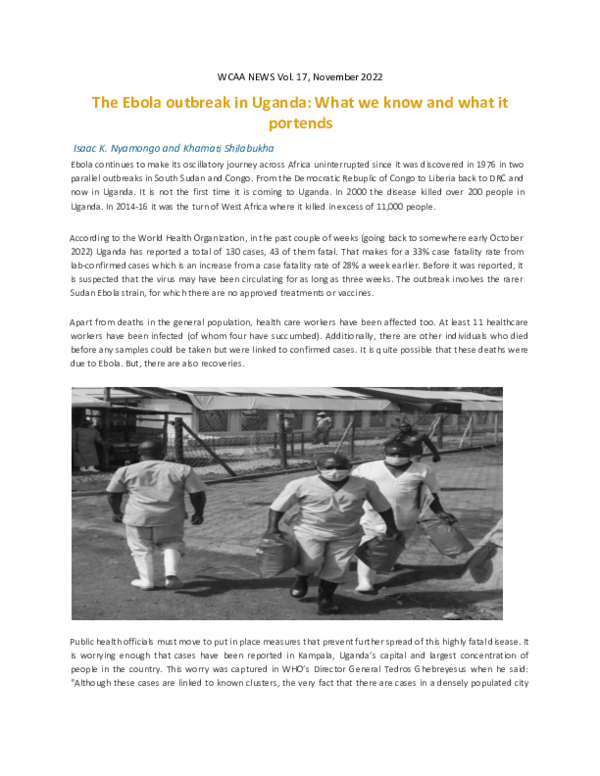Academia.edu no longer supports Internet Explorer.
To browse Academia.edu and the wider internet faster and more securely, please take a few seconds to upgrade your browser.
The Ebola outbreak in Uganda: What we know and what it portends
The Ebola outbreak in Uganda: What we know and what it portends
2022
This article highlights the increasing important role of anthropologists are playing in addressing the outbreak of epidemics like Ebola.
Related Papers
2014 •
2014 •
Background: A major challenge to outbreak control lies in early detection of viral haemorrhagic fevers (VHFs) in local community contexts during the critical initial stages of an epidemic, when risk of spreading is its highest (" the first mile "). In this paper we document how a major Ebola outbreak control effort in central Uganda in 2012 was experienced from the perspective of the community. We ask to what extent the community became a resource for early detection, and identify problems encountered with community health worker and social mobilization strategies. Methods: Analysis is based on first-hand ethnographic data from the center of a small Ebola outbreak in Luwero Country, Uganda, in 2012. Three of this paper's authors were engaged in an 18 month period of fieldwork on community health resources when the outbreak occurred. In total, 13 respondents from the outbreak site were interviewed, along with 21 key informants and 61 focus group respondents from nearby Kaguugo Parish. All informants were chosen through non-probability sampling sampling. Results: Our data illustrate the lack of credibility, from an emic perspective, of biomedical explanations which ignore local understandings. These explanations were undermined by an insensitivity to local culture, a mismatch between information circulated and the local interpretative framework, and the inability of the emergency response team to take the time needed to listen and empathize with community needs. Stigmatization of the local community – in particular its belief in amayembe spirits – fuelled historical distrust of the external health system and engendered community-level resistance to early detection. Conclusions: Given the available anthropological knowledge of a previous outbreak in Northern Uganda, it is surprising that so little serious effort was made this time round to take local sensibilities and culture into account. The " first mile " problem is not only a question of using local resources for early detection, but also of making use of the contextual cultural knowledge that has already been collected and is readily available. Despite remarkable technological innovations, outbreak control remains contingent upon human interaction and openness to cultural difference.
HISTORICKÁ SOCIOLOGIE
Konformita, společenský fenomén projevující se v chování většiny lidíThe manifestations of the public social conformity have caught the interest of authors, especially in recent decades. In past events they are searching for the answer to the question, why does the public, in its majority, adjust to changing political measures, why is it conformal. To get an answer it is required to analyze events, which lead to the adaptation of new conditions, not neccesarily only political ones. The conformity can be characterised both in its narrower and broader concept. In the narrower sense, it is the adjustment of thoughts and opinions, and in the broader sense it´s the adaptation of values and attitudes. Social mechanisms, institutions, community and the social group to which an individual belongs, support the conformity. It is shaped by circumstances of individual’s livelihood, by the conflict of social roles and the influence of the communication. The fundamentals and principles upheld by the prevailing social mechanisms, are aided by the “pressure” of the ...
Obed Frausto y Minerva Rojas Ruiz, "¿Sociedad del riesgo? Hacia la concepción de la sociedad del peligro y del terror" en Melina Gastélum y Liliana Valladares. Riesgo tecnocientífico en contextos de desigualdad ( México: UNAM, 2024)
¿Sociedad del riesgo? Hacia la concepción de la sociedad del peligro y del terror2024 •
La destrucción del reactor número 4 de la planta nuclear de Chernóbil fue uno de los peores desastres tecnocientíficos de los últimos tiempos. Las pérdidas humanas, la contaminación nuclear, los altos niveles de radiación y sus efectos producidos a kilómetros de distancia en Europa fueron motivo de las reflexiones de sociólogos alemanes que intentaron comprender esos efectos tecnocientíficos en la sociedad moderna.
While companies are investing increasingly in sustainability measures, the effects of firms' sustainability actions on consumer perceptions should not be taken for granted and deserve to be investigated. By adopting the interpretative lens of consumer culture theory, this paper defines a set of cognitive dimensions which can describe consumer perceptions of sustainability actions and the behaviors of small-medium enterprises (SMEs), with the aim of identifying the relationships between firms' sustainability actions and the economic performance of SMEs. To this extent, the cognitive dimensions proposed by Green & Petre (1996) are re-elaborated to define a set of customer cognitive dimensions in the sustainability domain (resilience, wholeness, mapping, coding, and engagement). Thus, the relationships between SMEs' sustainability actions and behaviors, the defined cognitive influencers and SME performance is empirically tested. In particular, a survey of a sample of 1137 customers of 175 Italian SMEs is analyzed using structural equation modelling (SEM). The findings show that the adoption of certain sustainability actions influences consumer perceptions, which in turn impacts the economic performance of SMEs.
RELATED PAPERS
평택출장안마『카아톡NW30 』ル「SOD30.NET」평택출장샵ル평택출장아가씨ル평택출장샵ル평택출장마사지ル평택모텔출장ル평택출장샵추천
평택출장안마『카아톡NW30 』ル「SOD30.NET」평택출장샵ル평택출장아가씨ル평택출장샵ル평택출장마사지ル평택모텔출장ル평택출장샵추천2020 •
Ecotoxicology and Environmental Safety
Effects of short time UV-A exposures on compound eyes and haematological parameters in Procambarus clarkii (Girad, 1852)2011 •
EPJ Web of Conferences
Experimental Testing of Single APM Spheres2010 •
Proceedings of The Royal Society B: Biological Sciences
Decline in top predator body size and changing climate alter trophic structure in an oceanic ecosystem2009 •
AAPS PharmSciTech
Physicochemical characterization and dissolution properties of nimesulide-cyclodextrin binary systems2003 •
Approaches to Hungarian
Contextual triggers of the Hungarian pre-verbal focus structure2020 •
The Journal of Physical Chemistry A
Some Quantum Chemical Aspects on Outer-Sphere Electron-Transfer Reactions: The U(V)/Fe(III)−U(VI)/Fe(II) System2006 •
2008 •

 Khamati Shilabukha, PhD
Khamati Shilabukha, PhD